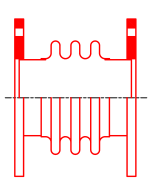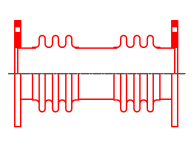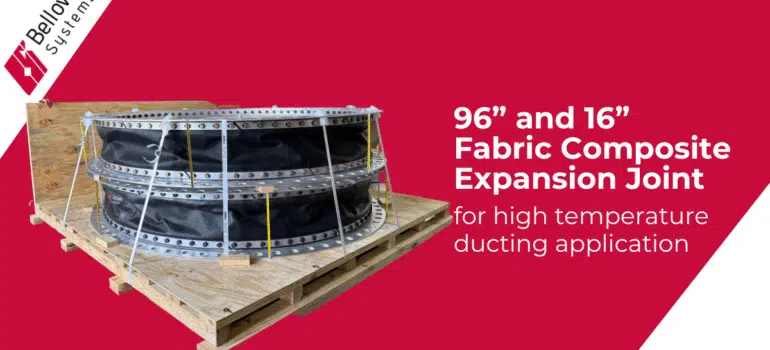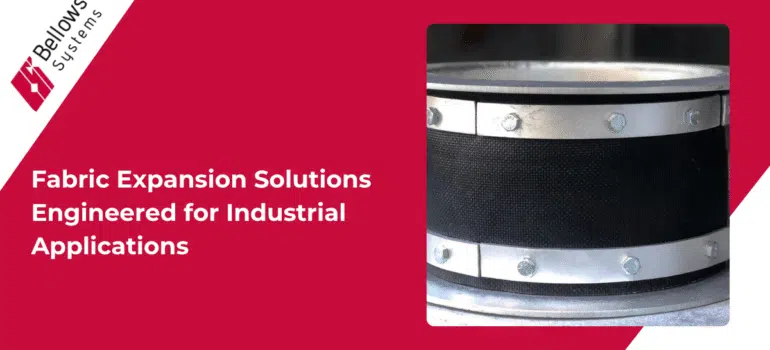Bellows Systems can manufacture custom Metal Expansion Joints in many different configurations to suit your application
Bellows Systems offers different types of Expansion Joints designs including simple single bellows element Expansion Joints to pressure balanced Expansion Joints for your piping or ducting needs. We utilize our standard metal bellows elements to rapidly assemble custom Metal Expansion Joints that meet your exact project requirements. Our OEM and custom Expansion Joints are used in a wide range of industries, from Oil and Gas, Aerospace, Power Gen, Petrochemical, Water and Wastewater.
Bellows Systems offers various end fitting options for our expansion joints including, pipe weld ends, Fixed flange, Floating flange, Marman Flange, Slotted Cuff Ends.
Bellows Systems additionally offers flow liners, control rods, external covers, thermal insulation as required for your application.
Want to discuss your requirements with our experts? Call us now
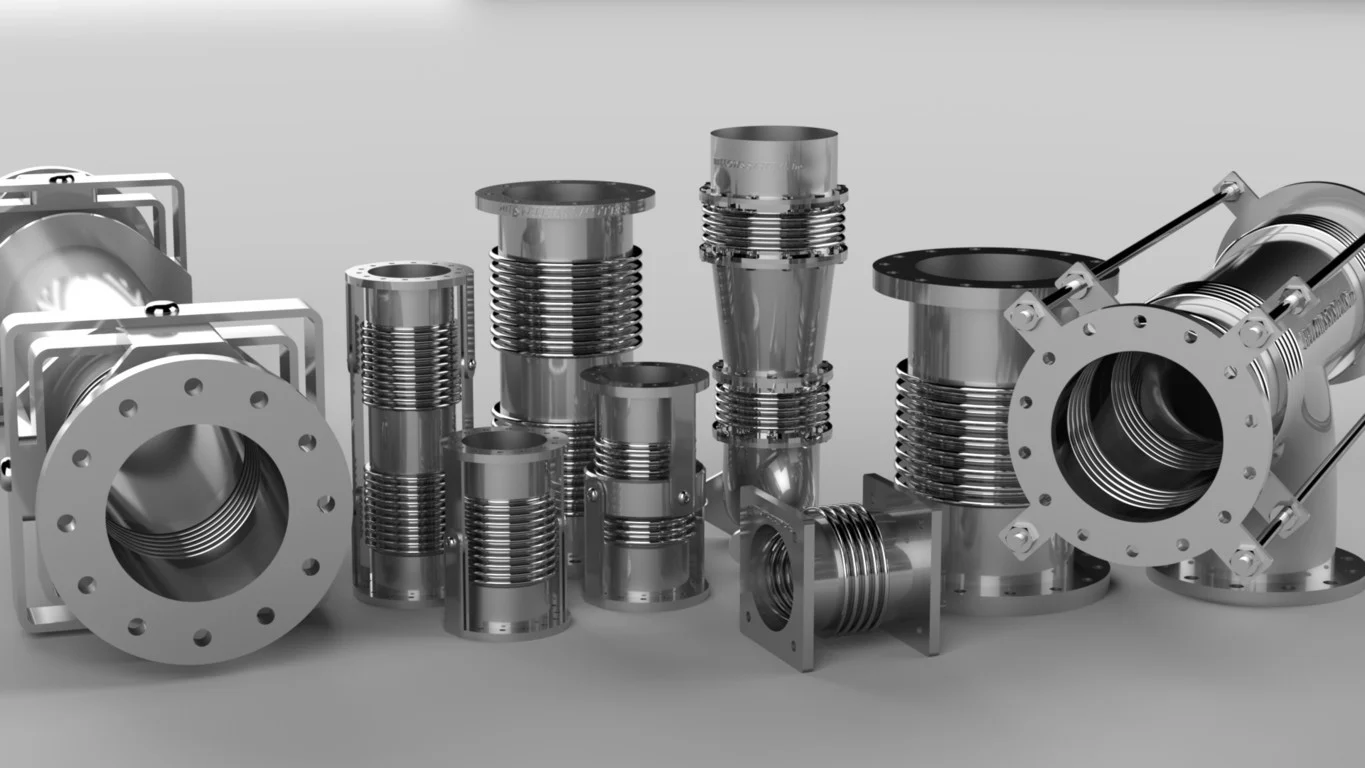

Stainless Steel Expansion Joints
Frequently Asked Questions
Metal bellows and expansion joints are commonly used in a variety of applications to compensate for thermal expansion, vibration, misalignment, and other types of movement in pipelines and equipment. Here are some common applications for metal bellows and expansion joints:
HVAC systems: Metal bellows and expansion joints are used in heating, ventilation, and air conditioning (HVAC) systems to absorb thermal expansion and contraction caused by changes in temperature and pressure.
Aerospace industry: Metal bellows are used in the aerospace industry for fuel lines, exhaust systems, and other applications that require flexibility and durability in extreme environments.
Petrochemical industry: Metal bellows and expansion joints are used in the petrochemical industry to compensate for movement and vibration in pipelines, reactors, and other equipment.
Power generation: Metal bellows and expansion joints are used in power plants to compensate for thermal expansion and vibration in piping and equipment.
Medical equipment: Metal bellows are used in medical equipment such as ventilators, anesthesia machines, and surgical robots to provide precise motion control.
Automotive industry: Metal bellows are used in automotive exhaust systems to absorb thermal expansion and contraction caused by changes in temperature.
Semiconductor industry: Metal bellows and expansion joints are used in the semiconductor industry to compensate for movement and vibration in vacuum chambers and other equipment.
These are just a few examples of the many applications for metal bellows and expansion joints.
Selecting the right material for metal bellows and expansion joints is important to ensure they are durable and reliable in specific industry applications. Here are some factors to consider when selecting the material:
Temperature: The material should be able to withstand the temperature range of the application. Different materials have different temperature limits, so it’s important to choose a material that can handle the expected temperature range.
Corrosion resistance: In industries where corrosive substances are present, it’s important to choose a material that is resistant to corrosion. Materials such as stainless steel and Inconel are often used for their corrosion-resistant properties.
Pressure: The material should be able to withstand the pressure of the application. Different materials have different pressure ratings, so it’s important to choose a material that can handle the expected pressure range.
Flexibility: The material should be flexible enough to accommodate movement and vibration in the application. Materials such as Inconel and titanium are often used for their high flexibility.
Cost: The cost of the material should be considered in relation to the specific industry application. Some materials are more expensive than others, so it’s important to choose a material that is cost-effective for the application.
It’s important to consult with a manufacturer or supplier of metal bellows and expansion joints to determine the best material for a specific industry application. They can provide guidance and recommendations based on their expertise and experience in the field.
Bellows Systems engineering and technical sales staff can assist you in making right material selection based on your application.
Some useful links,
There are several materials commonly used to manufacture metal bellows and expansion joints, and each material has unique properties that make it suitable for specific applications. Here are some of the most common materials used for metal bellows and expansion joints:
Stainless steel: Stainless steel is a popular material for metal bellows and expansion joints because of its excellent corrosion resistance, high strength, and durability. It can withstand high temperatures and pressures and is often used in industrial applications.
Inconel: Inconel is a nickel-chromium alloy that is highly resistant to corrosion and oxidation at high temperatures. It has excellent strength and durability and is often used in aerospace and chemical processing applications.
Titanium: Titanium is a lightweight and strong material that is highly resistant to corrosion. It has excellent flexibility and is often used in cryogenic and high-vibration applications.
Hastelloy: Hastelloy is a family of nickel-based alloys that are highly resistant to corrosion and high-temperature environments. It is often used in chemical processing and oil and gas applications.
Monel: Monel is a nickel-copper alloy that is highly resistant to corrosion in a wide range of environments, including seawater. It has excellent strength and is often used in marine and offshore applications.
Bronze: Bronze is a copper-based alloy that is often used in low-pressure and low-temperature applications. It has good corrosion resistance and is relatively inexpensive.
The choice of material will depend on the specific application and the requirements for temperature resistance, corrosion resistance, pressure resistance, flexibility, and cost. A qualified engineer or manufacturer can recommend the best material based on the application requirements.
Bellows Systems uses several standard testing and inspection processes to verify metal bellows and expansion joints. Here are some of the most common methods:
Visual inspection: Visual inspection is often the first step in verifying metal bellows and expansion joints. This involves a careful examination of the product for any signs of damage, corrosion, or other defects.
Hydrostatic testing: Hydrostatic testing is a method of testing the pressure capacity of metal bellows and expansion joints by filling them with water or another liquid and pressurizing them to a predetermined level.
Leak testing: Air leak testing is a method of testing the integrity of metal bellows and expansion joints by pressurizing them with gas (air) and using a surfactant (foaming agent) to detect any leaks.
Penetrant Testing (PT ) – also known as liquid penetrant inspection (LPI) or dye penetrant testing – is based on the properties of surface wetting and capillary action, which causes a liquid to rise when confined to a small surface openings/ defects.
X-ray (Radiography-RT) testing: X-ray testing are non-destructive testing methods used to detect any volumetric defects or cracks in the metal bellows and expansion joints welds.
Burst testing: Burst testing is a destructive testing method that involves pressurizing the metal bellows and expansion joints until they fail. This is done to determine the maximum pressure that the product can withstand before failure.
Pressure cycling: Pressure cycling is a method of testing metal bellows and expansion joints by repeatedly cycling them between high and low pressure to simulate the conditions of actual use.
The specific testing and inspection methods used will depend on the requirements of the application and the standards set by regulatory bodies.
Bellows Systems has qualified quality control inspectors that will typically perform these tests and inspections to ensure their products meet industry standards and customer requirements.
Yes, metal expansion joints can be used in high-temperature applications. The maximum temperature that metal expansion joints can withstand depends on several factors such as the type of metal used, the design of the expansion joint, and the specific application requirements.
The most commonly used metals for high-temperature expansion joints are stainless steel, Inconel, and Hastelloy. Stainless steel is often used in applications where the temperature range is between -100°C to 500°C (-148°F to 932°F), while Inconel and Hastelloy are used in more extreme temperature ranges up to 1100°C (2012°F) and 1200°C (2192°F), respectively.
The design of the expansion joint is also critical in determining its maximum temperature capability. For example, the bellows’ thickness and the number of plies in the expansion joint can affect its ability to withstand high temperatures. Additionally, the end fittings and welds used in the construction of the expansion joint must also be able to withstand the high temperatures.
It is important to note that the maximum temperature that an expansion joint can withstand also depends on the specific application and the conditions under which it is used. Factors such as the rate of temperature change, the pressure, the vibration, and the presence of corrosive materials can all affect the performance of an expansion joint at high temperatures. Therefore, it is crucial to consult with a qualified engineer or manufacturer to determine the appropriate type and design of the expansion joint for a specific high-temperature application.
The suitability of metal expansion joints for use in corrosive environments depends on several factors, including the specific type of metal used, the design of the expansion joint, and the nature and concentration of the corrosive material.
Stainless steel, Inconel, and Hastelloy are commonly used metals in expansion joints that offer excellent corrosion resistance. However, the effectiveness of these materials depends on the specific corrosive environment. For example, stainless steel is suitable for use in mildly acidic or alkaline environments, but it may not be suitable for use in more severe acidic environments. Inconel and Hastelloy, on the other hand, are more resistant to a wider range of corrosive materials, including acids and alkalis.
The design of the expansion joint can also affect its suitability for use in corrosive environments. For example, the use of multiple plies or thicker bellows can increase the corrosion resistance of the expansion joint.
In addition to the metal and design of the expansion joint, the nature and concentration of the corrosive material must also be considered. For example, some materials may cause localized corrosion or pitting in certain metals. Therefore, it is essential to consult with a qualified engineer or manufacturer to determine the appropriate type and design of the expansion joint for a specific corrosive environment.
Overall, metal expansion joints can be suitable for use in corrosive environments, but it is crucial to select the appropriate type of metal and design of the expansion joint for the specific application.
The typical lifespan of a metal expansion joint depends on various factors, including the type of metal used, the design of the expansion joint, the specific application, and the operating conditions. In general, a well-designed and properly installed metal expansion joint can last for many years.
The frequency of inspection and replacement of metal expansion joints also depends on several factors, including the operating conditions and the specific application. It is recommended that metal expansion joints be inspected regularly to identify signs of wear, damage, or other issues that could affect their performance. The frequency of inspection and replacement can vary from every few months to several years, depending on the operating conditions and the specific application.
It is also important to note that the failure of an expansion joint can have severe consequences, including damage to equipment, downtime, and safety hazards. Therefore, it is essential to have a proactive maintenance and inspection program in place to ensure the ongoing performance and safety of metal expansion joints.
In summary, the typical lifespan of a metal expansion joint varies based on several factors. Regular inspection and maintenance are essential to identify potential issues and ensure the safe and reliable operation of the expansion joint. The specific frequency of inspection and replacement should be determined based on the operating conditions and the specific application.
The maintenance and inspection procedures for metal expansion joints used in industrial OEM applications depend on various factors, including the type of metal used, the design of the expansion joint, the specific application, and the operating conditions. However, here are some common maintenance and inspection procedures for metal expansion joints:
Regular visual inspection: Regular visual inspection should be performed to identify any signs of wear, damage, or other issues that could affect the performance of the expansion joint. The frequency of inspection depends on the operating conditions and the specific application, but it is typically recommended to inspect the expansion joint every 6-12 months.
Check for leaks: The expansion joint should be checked for leaks, which can occur due to wear, damage, or improper installation. This check can be performed using a leak detector or by visual inspection.
Check for deformation or misalignment: The expansion joint should be checked for any deformation or misalignment that could affect its ability to absorb thermal or mechanical movements. This check can be performed by visual inspection or by measuring the deflection of the expansion joint.
Clean the expansion joint: The expansion joint should be kept clean to prevent the accumulation of debris or other materials that could interfere with its movement or cause corrosion.
Lubricate the expansion joint: Some expansion joint types ( hinged, gimbal and universal) may require lubrication to facilitate its movement and prevent wear. The type and frequency of lubrication depend on the specific application and the operating conditions.
Replace worn or damaged components: If any components of the expansion joint are worn or damaged, they should be replaced promptly to ensure the safe and reliable operation of the expansion joint.
The specific frequency and procedures for maintenance and inspection of metal expansion joints depend on the specific application and operating conditions. It is recommended to consult with a qualified engineer or manufacturer to determine the appropriate maintenance and inspection program for a specific application.
Latest News & Blog

